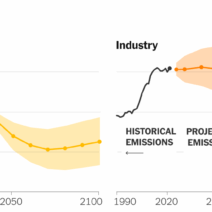The vast bodies of water that make up our oceans serve as a fundamental component of the Earth’s climate system. Collectively dubbed the “ocean’s thermostat,” they significantly influence global temperatures through a complex interplay of temperature variation and circulation patterns. Understanding the mechanisms at work within this aquatic regulator is crucial, particularly in the context of ongoing global warming and its multifaceted impacts on the planet.
The ocean acts as a colossal thermal reservoir, absorbing, storing, and redistributing solar energy. It has the unique capability to retain heat due to its high specific heat capacity. As a result, oceans modulate the climate more effectively than land does. Water can absorb large amounts of heat without a corresponding increase in temperature, allowing it to buffer the effects of climate fluctuations. However, this buffering capacity is not without limits. As ocean temperatures rise, the ramifications extend far beyond elevated sea surface temperatures.
Circulation patterns are central to the way the ocean functions as a thermostat. The ocean’s currents, driven by wind, the Earth’s rotation, and differences in water density, facilitate the transport of warm and cold water across vast distances. This systemic movement is epitomized by the global conveyor belt, a network of surface and deep ocean currents that redistribute thermal energy around the globe. In simpler terms, warm water is transported from the equator toward the poles, while cold water flows back toward the equator. This exchange is integral to regulating the Earth’s climate, influencing everything from precipitation patterns to the likelihood of extreme weather events.
One of the most fascinating aspects of ocean circulation is its impact on regional climates. For example, the Gulf Stream, a warm ocean current in the North Atlantic, plays a pivotal role in moderating temperatures in Western Europe. Without this current, regions that currently enjoy temperate climates could devolve into vastly colder environments. Conversely, the melting of polar ice caps, a direct consequence of rising global temperatures, adds freshwater to the North Atlantic, potentially disrupting these established currents. Such disruptions could alter wind patterns, precipitation, and even the frequency of tropical storms, leading to widespread ecological and economic consequences.
The phenomenon of ocean acidification is another critical consequence of increased atmospheric carbon dioxide, exacerbated by rising temperatures. The oceans absorb close to 30% of anthropogenic CO2 emissions, fundamentally altering the ocean’s chemistry. As CO2 dissolves in seawater, it forms carbonic acid, which decreases pH levels, adversely affecting marine life. Coral reefs, which host a rich diversity of marine species, are particularly vulnerable. Their calcification processes are hindered in acidic waters, leading to reef degradation and the loss of biodiversity. This loss is not merely an ecological tragedy; it threatens the livelihoods of millions who depend on these ecosystems for food and income.
Moreover, warmer ocean temperatures lead to alterations in biological productivity. Oceanic phytoplankton, the foundation of the marine food web, rely on nutrient availability and temperature conditions for growth. As temperatures rise and stratification increases, it can limit the upwelling of nutrient-rich water, leading to diminished primary productivity. This, in turn, has cascading effects up through the marine food web, impacting fish populations and the communities reliant on them for sustenance.
In addition to these direct effects, warming oceans have far-reaching implications for global weather patterns. The interaction between ocean temperatures and atmospheric conditions is a driving force behind phenomena such as El Niño and La Niña. These oscillations can lead to extreme weather events, from floods to droughts. The increased intensity and frequency of storms can be partially attributed to warmer ocean waters, as they provide more energy to developing systems. This unpredictability can wreak havoc on agriculture, infrastructure, and ecosystems worldwide, heightening vulnerabilities in regions already prone to climate-related disruptions.
The concept of the “ocean’s thermostat” also highlights societal attitudes toward climate change. As oceans shift under the weight of climate change, there is a pressing need for collective action. Understanding the intricate relationships between ocean temperatures, circulation, and climate can foster a better grasp of our responsibility towards this vital resource. While oceans absorb a tremendous amount of CO2, they are not a panacea. The longer we wait to address greenhouse gas emissions, the greater the potential for irreversible damage to marine and terrestrial ecosystems alike.
Addressing climate change necessitates interdisciplinary approaches, merging marine science, atmospheric studies, and socio-political action. Conservation efforts toward sustainable fisheries, reducing plastic pollution, and restoring marine habitats are all essential strategies. These actions must be rooted in scientific understanding of how ocean dynamics function as climate regulators. Additionally, societies should invest in clean energy and increase resource efficiency to mitigate the anthropogenic impacts on the oceans.
In conclusion, the oceans serve as our planet’s thermostat, playing a critical role in regulating climate through their temperature dynamics and circulation patterns. Their health is integrally woven into the fabric of the Earth’s climate system, influencing weather patterns, marine biodiversity, and ultimately human livelihoods. Recognizing the ocean’s multifaceted contributions to our climate can deepen our understanding and appreciation of this invaluable resource while underscoring the urgency of combating climate change for the sake of current and future generations.







